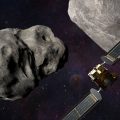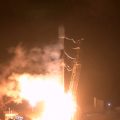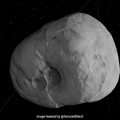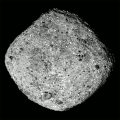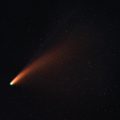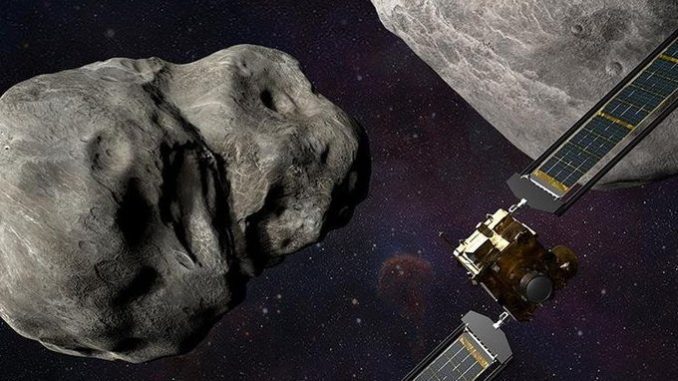
The asteroid, Dimorphos, is the size of a stadium — or the Great Pyramid of Giza, as one scientist put it Monday — and is about 7 million miles from Earth. It orbits a giant asteroid named Didymos. Neither poses a threat to our planet now or anytime in the foreseeable future.
This was just a test, NASA’s first demonstration of a potential planetary defense technique called a kinetic impactor. The idea is to give a hypothetically dangerous asteroid just enough of a blow to alter its orbital trajectory.
Launched last November from California, the spacecraft was small, roughly the size of a vending machine or golf cart. Dimorphous is approximately 500 feet or so in diameter, although its precise shape and composition were unknown before the final approach. Scientists anticipated a plume of debris from the asteroid upon impact but no significant structural change. This is more akin to a bug splattering on a windshield.
“This isn’t just bowling-ball physics,” Applied Physics Laboratory planetary scientist Nancy Chabot told reporters. “The spacecraft’s gonna lose.”
But even small effects on an asteroid’s movement could prove a planet-saver. An early collision with an asteroid, if done early enough — say, 5 to 10 years in advance of its projected encounter with Earth — could be enough to slow it down and make it miss.
Thousands of potentially hazardous asteroids come close to, or cross, the Earth’s orbital path around the sun. None is currently known to be on a trajectory to hit the planet.
As engineers conceived of an asteroid deflection mission, they seized on an ingenious idea that would greatly reduce the costs: Hit an asteroid “moonlet” that’s orbiting a larger asteroid.
To detect the effect of a collision with a single asteroid orbiting the sun would have required two spacecraft, engineer Andrew Cheng told reporters, because such an asteroid is moving at tremendous speed, and the impact from a small spacecraft would result in a minimal, hard-to-detect change. A second spacecraft would have to be present to scrutinize the effect.
But a moonlet, like Dimorphos, orbits its larger twin at a stately pace. The effect of the impact should be more easily detected — including by telescopes on Earth and in space. No second spacecraft is necessary.
It will take at least a couple of days to tell if the DART mission succeeded in slowing down the targeted asteroid and to what degree it did so. Telescopes on Earth and in space observed the collision, as did a small instrument called a cubesat, deployed 15 days before impact.
This is an unusual mission in that it does not involve a spacecraft trying to survive a hazardous landing on an alien world or proving itself operational in the harsh environment of outer space, noted Robert Braun, head of the space exploration sector at the Applied Physics Laboratory.
Did you catch the #DARTMission stream live or Didymos it? Impact is over, but the research continues. As scientists delve into data and telescopes release images of the asteroid from their POV, follow @AsteroidWatch and @NASASolarSystem for updates. https://t.co/ZNEYDQVA8Y pic.twitter.com/dn2veS6zbG
— NASA (@NASA) September 27, 2022
“Here, we’re looking for a loss of signal,” he told reporters before the collision. “What we’re cheering for is a loss of the spacecraft.”
By Monday afternoon, the engineers in Laurel had sent their final course corrections to the DART spacecraft. From that point, it was on its own, making final navigational adjustments autonomously. The vehicle was aimed directly at the larger, brighter asteroid but programmed to fire thrusters that would pivot it toward the smaller asteroid when it came into view.
Some bizarre scenarios could not be ruled out because the asteroid’s shape wouldn’t be determined until the final hour before impact. Indeed, only the more giant asteroid — not Dimorphos — could be seen in the live feed from the spacecraft’s camera 90 minutes before the crash.
“If we were right on course, and it was shaped like a doughnut, we’d fly right through it,” Braun said.
NASA DART mission successfully crashes spacecraft into asteroid – The Washington Post https://t.co/xRnzq1A8kO pic.twitter.com/S9WvIeaYDG
— 隣町の図書館 (@Nagas_K) September 27, 2022
Not until the final minutes of DART’s journey did the spacecraft or its human operators back on Earth get a good look at Dimorphos. It wasn’t visible at all until about an hour before impact. Even then, it was just a tiny, barely perceptible dot next to its brighter twin.
There was joy in the Mission Operations Center as the asteroid loomed larger on the screen. About 50 minutes before impact, project manager Edward Reynolds began uttering the same phrase: “This is nominal, this is nominal” — aerospace engineering jargon for “everything going exactly as planned,” he said later.
“We’ve locked on Dimorphos,” engineer Elena Adams reported 27 minutes before impact.
The camera onboard kept snapping away. The dot grew into a spherical rock with a rough, boulder-covered surface, looking like something you’d keep in the garage as a scouring tool. In the Mission Operations Center, the engineers stood and cheered through the final moments, too excited to sit at their consoles.
In the last image, Dimorphos filled the frame. DART was hitting the bull’s eye.
Then came a blank screen. DART had succeeded and ceased to exist.
“Impact confirmed for the world’s first planetary defense test mission,” NASA’s live-streamed broadcast announced.
On the NASA feed, the agency’s administrator, Bill Nelson, declared that the mission had demonstrated technology “to save our planet.” Ralph Semmel, director of the Applied Physics Laboratory, said he felt an adrenaline rush as DART made a direct hit on the target: “Never before have I been so excited to see a signal go away.”

